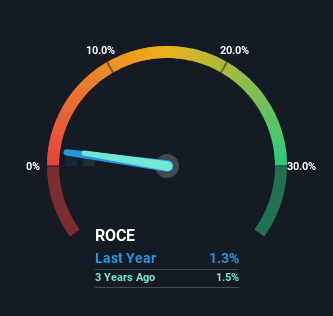Be Wary Of Asia Pacific Wire & Cable (NASDAQ:APWC) And Its Returns On Capital
When we're researching a company, it's sometimes hard to find the warning signs, but there are some financial metrics that can help spot trouble early. More often than not, we'll see a declining return on capital employed (ROCE) and a declining amount of capital employed. This combination can tell you that not only is the company investing less, it's earning less on what it does invest. In light of that, from a first glance at Asia Pacific Wire & Cable (NASDAQ:APWC), we've spotted some signs that it could be struggling, so let's investigate.
What Is Return On Capital Employed (ROCE)?
If you haven't worked with ROCE before, it measures the 'return' (pre-tax profit) a company generates from capital employed in its business. To calculate this metric for Asia Pacific Wire & Cable, this is the formula:
Return on Capital Employed = Earnings Before Interest and Tax (EBIT) ÷ (Total Assets - Current Liabilities)
0.013 = US$2.8m ÷ (US$345m - US$125m) (Based on the trailing twelve months to June 2023).
Therefore, Asia Pacific Wire & Cable has an ROCE of 1.3%. In absolute terms, that's a low return and it also under-performs the Electrical industry average of 13%.
Check out our latest analysis for Asia Pacific Wire & Cable
Historical performance is a great place to start when researching a stock so above you can see the gauge for Asia Pacific Wire & Cable's ROCE against it's prior returns. If you're interested in investigating Asia Pacific Wire & Cable's past further, check out this free graph of past earnings, revenue and cash flow.
How Are Returns Trending?
We are a bit worried about the trend of returns on capital at Asia Pacific Wire & Cable. Unfortunately the returns on capital have diminished from the 5.1% that they were earning five years ago. Meanwhile, capital employed in the business has stayed roughly the flat over the period. Companies that exhibit these attributes tend to not be shrinking, but they can be mature and facing pressure on their margins from competition. So because these trends aren't typically conducive to creating a multi-bagger, we wouldn't hold our breath on Asia Pacific Wire & Cable becoming one if things continue as they have.
The Key Takeaway
In summary, it's unfortunate that Asia Pacific Wire & Cable is generating lower returns from the same amount of capital. It should come as no surprise then that the stock has fallen 31% over the last five years, so it looks like investors are recognizing these changes. That being the case, unless the underlying trends revert to a more positive trajectory, we'd consider looking elsewhere.
On a final note, we found 3 warning signs for Asia Pacific Wire & Cable (1 doesn't sit too well with us) you should be aware of.
While Asia Pacific Wire & Cable may not currently earn the highest returns, we've compiled a list of companies that currently earn more than 25% return on equity. Check out this free list here.
Have feedback on this article? Concerned about the content? Get in touch with us directly. Alternatively, email editorial-team (at) simplywallst.com.
This article by Simply Wall St is general in nature. We provide commentary based on historical data and analyst forecasts only using an unbiased methodology and our articles are not intended to be financial advice. It does not constitute a recommendation to buy or sell any stock, and does not take account of your objectives, or your financial situation. We aim to bring you long-term focused analysis driven by fundamental data. Note that our analysis may not factor in the latest price-sensitive company announcements or qualitative material. Simply Wall St has no position in any stocks mentioned.

